Just before 05:15 I rocked up at the terminal entrance and made my way in. I declared myself - and one of the two hosts of the day welcome me to the airport.
I was then given an overview of the operation and the check-in area - seeing the support for airlines at London City is growing. They also mentioned a little timesaver for those travellers who have items to check in - the option to self tag bags. After this, it was time to head through Staff and Crew Security (through the most nondescript door), and after completing the usual aviation security, my escort and I were cleared to proceed.
We checked in with the Operations Team where I was greeted, and given an overview of what operations do for the airport - from checking runway lights are all working, to giving the go order open or shut the airport, to reporting on conditions on the tarmac. Which for the day of my visit - was soaking wet.
 The truck waiting to take us on inspection
The truck waiting to take us on inspection
For the first part of the check, we needed to go off site to inspect the Instrument Landing System Lights (ILS) to check all the lights were functional. For LCY, this means taking a truck out into the local area, and inspecting ILS from local bridges.
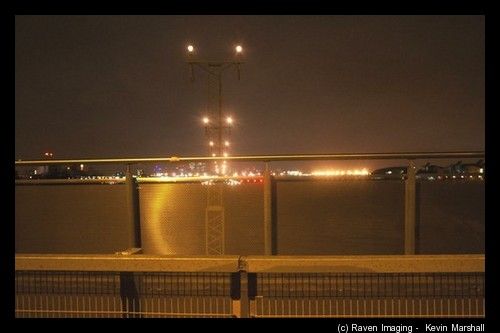 Looking towards 09 (Towards Canary Wharf)
Looking towards 09 (Towards Canary Wharf)
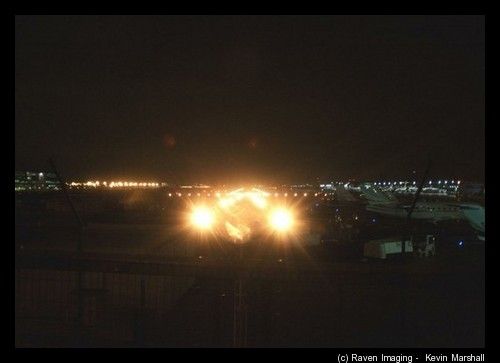 Looking towards 27 (Towards the JetCentre at London City Airport)
Looking towards 27 (Towards the JetCentre at London City Airport)
London City has one physical runway, but two approaches and departure points (like most runways). Departing from/Landing on Runway 27 heads towards Canary Wharf, whilst departing/arriving on Runway 9 heads towards the Thames.
This can be fun when boats decide to exit moorings and close bridges, but the ops inspector was in contact with tower to switch on and off the lights as needed, checking for blown bulbs.
Bulbs both on the ILS and on the Runway/Taxiways/turns are normally changed in the shut-down period LCY has every week - when the airport shuts to traffic from 12:30 on Saturday to 12:30 on Sunday. Emergency repairs can also be done if there are some major lighting failures - contributing to the safety factor.
Once the external checks were complete, it was time to re-enter airport premises. As there was traffic at the entrance to the airport (called the airlock for vehicles entering the secure side), my escort and I disembarked and re-cleared security.
Another member of the ops team met us to continue to the air-side check of broken bulbs, checking through the taxiways, and the runway itself driving up and down the full length of the runway.
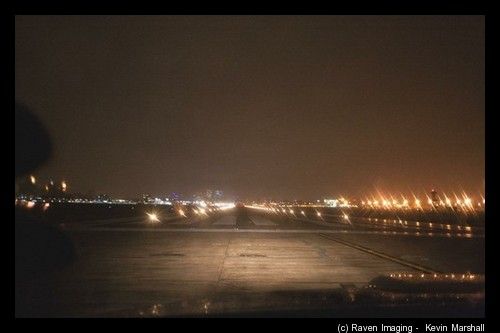 In the truck, looking down runway 27 towards Canary Wharf
In the truck, looking down runway 27 towards Canary Wharf
 Checking the runway makers are working near Alpha
Checking the runway makers are working near Alpha
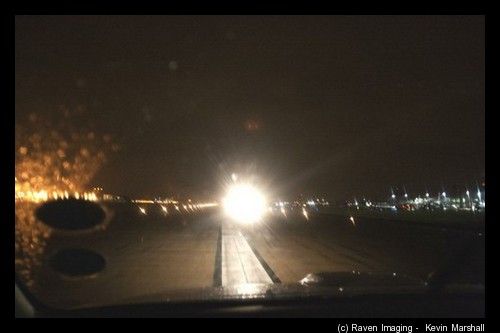 Even first thing in the morning, there's traffic on the runway - a fire service truck completing its sweep.
Even first thing in the morning, there's traffic on the runway - a fire service truck completing its sweep.
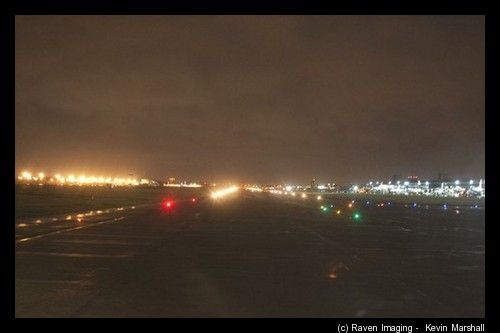 Looking up runway 9
Looking up runway 9
The ops inspector was in constant contact, asking sections of lights to be switched off and on as needed, and noting which lights were dead - or not (for example one light was out on a Wigwam - an active runway light indicator - to which the response from control
"Which is out - wig or wam" comes over the radio).
Whilst it was Friday, it was a professional discussion - and much like a family at work - that came over a lot during the visit.
After the runway inspection was passed (the first of four during the day), it was coming up on 06:25 local. This is the point where control of the runway is handed over from London City Airport Operations to NATS (National Air Traffic Services - or NATS Holdings), where the 1,500 meter concrete pavement turns from a piece of concrete to an active runway where planes are allowed to land. During the communication, conditions are also broadcast on the runway (on the day I was there - wet was the condition of the day).
Timing is critical at London City Airport as the airport has major restrictions in operational times due to noise:
Monday to Friday - 06:30 to 22:00
Saturday 06:30 to 12:30
Sunday 12:30 to 22:00
For the operations team, it's important to keep to those times as there is a risk of fines operating outside those hours, and the fact the first plane is due to push-back at 06:30 and the first arrival into the airport isn't far behind.
And as we pulled into towards JetCentre and Ramp operations, you can tell the pride the operations team have working there - and the consideration to safety needed to operate the airport professionally.
And that matters a lot.
--
After the inspection vehicle had dropped my escort and myself outside JetCentre, we headed up to Ramp control to shadow their operations for a while.
Ramp control as the name suggests controls activity on the ramp and apron of the airport, warning handling crews what time planes are due in, and where. And no matter the time of the day, it’s a busy place with lots of people managing a small airport.
Today, two people were managing the morning arrivals and morning departures rush, with another two handing reporting and planning.
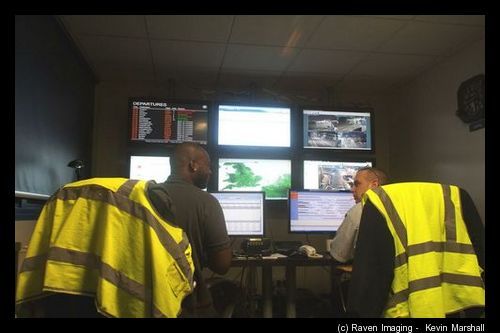 Conversing in a quiet moment
Conversing in a quiet moment
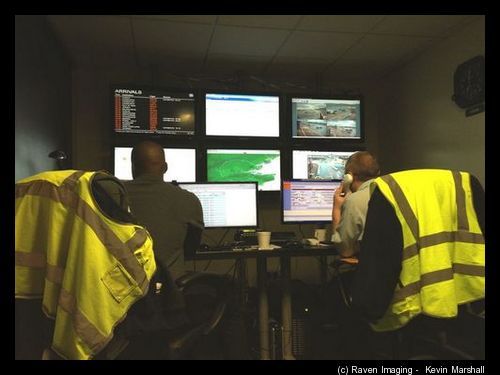
Answering a query on a plane that is staying a bit longer than intended
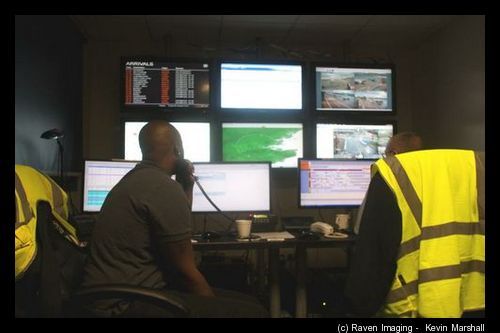
Talking to the ramp.
It’s the place that controls the buses and where the planes park.
So… a rather important spot.
The screens are rather interesting – but for a lot of us – the one with a map of the South East of England is the one that holds most interest. If you look at the screen carefully, you’ll see a ring drawn around it. Depending on the runway and how it is used it’s 10 minutes to the airport if on a river approach, 15 if coming from the rest of UK.
And in those 10 minutes, ramp workers need to be notified, and stands need to be confirmed – with confirmation at 10 minutes normally. Of course if there is a major rush, its a case of get the plane down and then get it to a stand.
There was some issues in the past of parking the bigger planes at the airport – especially since the Embraer 170/190′s are becoming very popular at the airport over the older AvroRJ/BAe-146 series. Thankfully the stands have been re-configured so that all but two stands can now cope with any regional aircraft (The British Airways A318′s that have to live at the apron near Gate 23/24).
Of course, planes don’t exactly always obey timings and irregular operations happen – that’s when this team re-plan and identify the changes that need to be made as needed.
There is a lot of dual working – and sometimes three person working when extra busy to handle radio and telephone communications.
Handling of arrivals, departures and what work needs to be done is managed from a constantly updated planning tool – and it allows for long range planning for 6 hours and beyond. However, there are things that come into play that can cause issues – for example the day I was there a NOTAM (Notice To Airmen) was issued that Strong winds were expected in the LCY area from 08:00 – this impacts on landings – and possible go-arounds too.
Other things that can impact are snow, Fog (an issue London City suffers due to it being slap bang in the middle of the Royal Albert Docks, and the River Thames to the side of it) and of course – bird strikes. Should systems go down (dread the thought), the operation can be split with staff pitching up at operations, whilst others are working ramp control at ops and working over radios till systems can be brought back up.
It’s a tough operation – but the team mange it with ease.
The ramp teams work in groups of 8-9 depending on the loads and the shifts to meet the deadlines that airline managers put on them to turn planes around – and as a lot of aircraft “pit stop” only at LCY, they need to make sure the right balance of people are assigned. For example:
- For an AvroRJ/BAe146, or a TurboProp 2 people can manage the load/unload and prep of the aircraft
- For an ERJ, becaue of the extra load of passengers and cargo they can hold, three people are needed.
- Lufthansa/Swiss CRJ’s have requirements where to place bags in the hold
The number of people also depends on the load and what cargo is handled – so constant replanning is needed to ensure a top quality service. It also allows the airport to bring in staff as needed in a controlled manner as opposed to just over-hiring people – allowing costs to be controlled.
It also allows the right people to be on-site too – so for example, more staff can be pulled in on the busy mornings on Monday and Tuesday, whilst reducing the need for people that are needed for Saturday morning.
That’s important because the costs that are spent at an airport have to be paid by an airline – which eventually goes into the price of the ticket we pay to fly.
There are challenges to the posts that are run by Ramp control – for example the constant repeating of information and sometimes the ramp workers wondering why things are done a certain way. Ramp Control are planning more “experience days” to share the knowledge and information that they do with the ramp workers – and show them the impact the decision made in control have on the ground, with the impact those decisions have.
And what an interesting challenge they have there, squeezing in the departures and arrivals, getting bags loaded and unloaded, fuelling planes, ensuring stands are available, if buses are needed and where to make them accessible.
---
As my escort and I left Ramp Control, we passed through JetCentre on the way through.
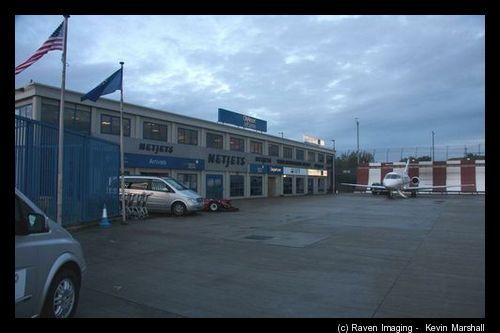
JetCentre as the name suggests is where the corporate jets and fractional operators (such as NetJets) are based. This area lies to the West of the airport near (beyond Gate 1 towards Canary Wharf and the City).
And London City can handle a fair few types:
- BE20 Beechcraft 200
- BE9L Beechcraft 900
- BE58 PA Beechcraft Baron B300 Beechcraft
- Beech 400 XP
- Hawker 800 XP
- C510 (Citation Mustang)
- C550 (Citation II)
- C560 (Citation V)
- C525 CJ1 (Citation Jet 1)
- C525 CJ2 (Citation Jet 2)
- C525 CJ3 (Citation Jet 3)
- C550 (Citation Bravo)
- C56X (Citation Excel)
- C680 (Citation Soverign)
- EMB 135BJ (Legacy)
- FA10 (Falcon 10
- FA50 (Falcon 50)
- F7X (Falcon 7X)
- F900EX (Falcon 900EX)
- F200 EX/LX (Dassault Falcon 2000 EX/LX)
- Bombardier Challenger 605 (CL60)
- Learjet 45 (LJ45)
- P180 (Piaggio Avanti)
- G150 (Gulfstream 150)
Whilst there is a great variation in that list, that covers anything from a short range prop (such as the P180 to a tri-engined business jet that is Trans-Atlantic capable (Dassault Falcon F7X - subject to payload, fuel and runway length) - a great range of aircraft
The base has the full facilities needed for handling, catering, immigration and supports a full crew setup and briefing too so everything can be contained on-site and in one building - allowing a quick in and out that those corporate jet fliers demand.
Now, you'll have to forgive my plane spotting spotting abilities. Big commercial stuff from a CRJ up to an A380 I can spot without a hint of trouble - Corporate Jets are a bit more difficult!
When I left the JetCentre, there were 5 private jets parked - 4 overnight and 1 that had just arrived.
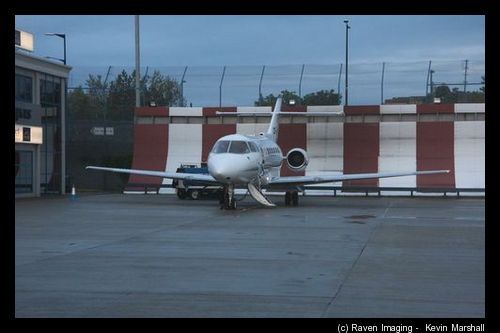
 The recent arrival and the ramp crew inspecting as needed
The recent arrival and the ramp crew inspecting as needed
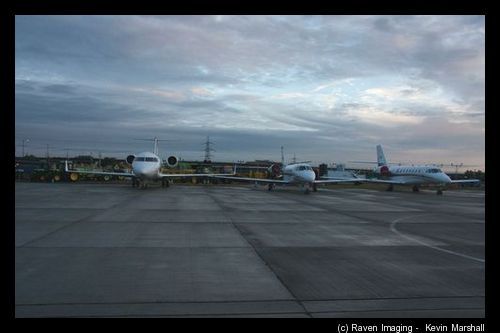
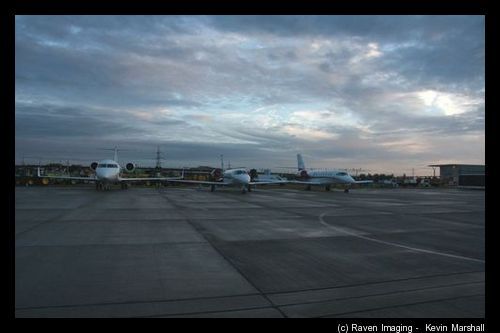 Three private jets in a row parked up at the JetCentre
Three private jets in a row parked up at the JetCentre
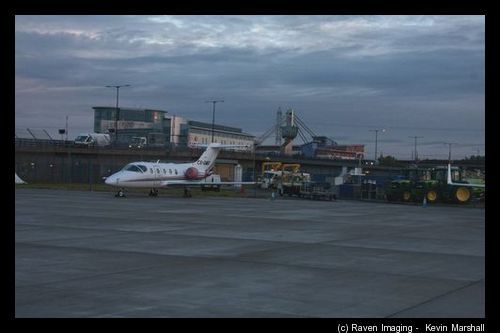
One more in a corner - note the equipment behind it.
Also stored at this end of the airport is the Winter Equipment (Snow Clearing) and the Fire Service Practice Rig (that
Miles from Blighty wrote about on his visit). Whilst London City Airport suffers from fog and low visibility, keeping the runway and airport open during snow doesn't appear to be a problem for them due to the time it takes to clear the snow, and how quick they can open the runway again.
Being prepared for anything strikes me as one of the things I'll take away from visiting LCY - from ground, terminal, corporate and commercial aviation - a great way to run an airport.
Next - Ramp Walks!